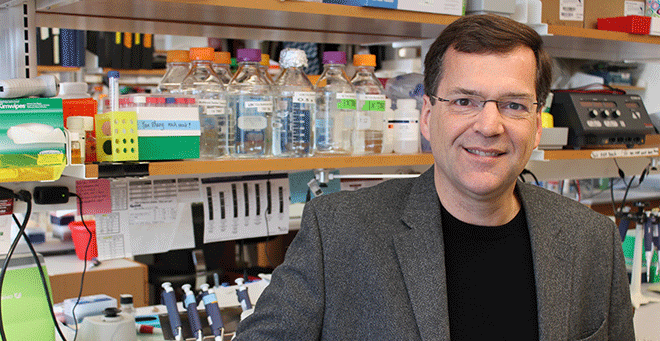Barely a decade after CRISPR gene-editing was discovered, the first medical treatment based on this revolutionary technology was approved by the U.S. Food and Drug Administration and now people with sickle cell disease, a painful, life-limiting, inherited blood disorder, have the potential for a cure.
“This is the first of hopefully many treatments to come that try to directly repair mutations in the genome,” said Scot Wolfe, PhD, professor of molecular, cell & cancer biology at UMass Chan Medical School. “There is a multitude of diseases associated with a single gene and if you can go in and repair the gene, you can solve the problem.”
On Dec. 8, 2023, the U.S. Food and Drug Administration approved a treatment for sickle cell disease called Casgevy, made by companies Vertex and CRISPR Therapeutics.
Sickle cell disease afflicts approximately 100,000 people in the United States, largely people of African descent. The FDA-approved gene-editing treatment can also be used on types of a related blood disorder called beta thalassemia.
How does CRISPR technology repair the gene?
Dr. Wolfe explained that in sickle cell disease, the beta globin gene—a protein component that is part of oxygen-transporting hemoglobin—has a mutation that causes adult hemoglobin to clump and change red blood cells, which are usually disc shaped, into a sickle shape. These sickle cells can clog blood vessels, prevent oxygen from getting to organs and increase inflammation in the body, which leads to pain, anemia and life-threatening conditions.
Babies don’t make adult hemoglobin, however. They make fetal hemoglobin, which contains gamma globin instead of beta globin. Consequently, babies in whom both copies of the beta globin contain the sickle cell mutation are not initially affected by sickle cell anemia. About a year after birth, a genetic signal shuts off fetal hemoglobin production, resulting in production of adult hemoglobin that may have the sickle cell mutation.
CRISPR tools have been developed to disable the off switch in the human genome for fetal hemoglobin production in red blood cells. When used, healthy fetal hemoglobin is made, which can compensate for defective adult hemoglobin and prevent red blood cell sickling.
“The beauty of the CRISPR system is that targeting to edit a specific sequence in the genome is defined by a small RNA, which you can change to manipulate where your effector will go in the genome,” said Wolfe. “It’s sort of like having an address book, with a specific address you could type into Google Maps and it’s going to tell you how to get there.”
CRISPR-based treatment involves harvesting bone marrow stem cells that produce all types of blood cells from a patient. Those stem cells are then treated with CRISPR reagents: in this case, a Cas9 that is programmed with a small RNA to direct its enzymatic activity to a specific site in the genome to inactivate the off switch for fetal hemoglobin. With a quick pulse of electricity, the stem cells open up and the Cas9 protein gets in, where it finds the location of the genome where it’s supposed to act, based on the RNA that it’s been programmed with.
Cas9 is an enzyme that makes a break in the DNA strands at the target sequence, which causes the DNA repair machinery in the cell to put things back together, Wolfe explained. “That process disrupts a regulatory element, or command, within the genome that tells a certain gene to get turned on at a specific time. And in this case, the command that gets disrupted is the one that would otherwise tell a particular protein to turn off fetal hemoglobin,” Wolfe said.
After the cells are treated, they are reinfused into the patient.
“So far, based on the CRISPR treatment they’ve done on more than 40 patients, the majority of them no longer have severe complications from sickle cell disease, or going to the hospital or having pain crises,” said Wolfe.
Wolfe said that while removing, treating and returning stem cells for the blood system is relatively straightforward, the transplant procedure is arduous.
“Delivery to other organ systems is a huge barrier for these therapies right now, but we’ll overcome that,” Wolfe said. “The exciting thing is that if you can manipulate the genome, it offers the possibility of permanent cures for patients who are suffering from disease.”
Science for Living features the perspectives of UMass Chan Medical School experts on the research behind health news headlines. If you have ideas for topics you’d like to see explored, please send them to susan.spencer1@umassmed.edu.


